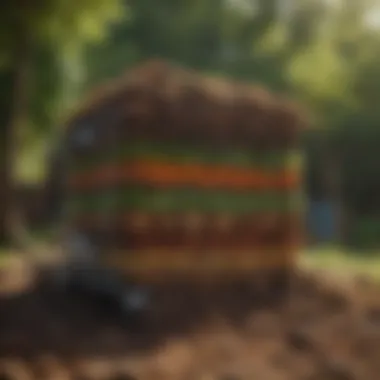Essential Guide to Successful Home Composting


Intro
Home composting is increasingly gaining traction among those who seek sustainable solutions for organic waste management. As logistics of waste disposal become more cumbersome, many individuals look for practical and eco-friendly alternatives. Composting not only helps in recycling waste but also revives the health of the soil, making it a crucial practice for anyone invested in gardening or environmental conservation. This guide will explore the components of home composting, optimal conditions for success, and methods to create a practical compost system.
Essential Components of Home Composting
Successful composting relies on several key components. Knowing these elements can simplify the process and lead to a thriving compost pile.
Organic Material
Organic materials are at the core of any composting process. These materials can be broadly categorized into two types:
- Green materials: This includes kitchen scraps such as vegetable peelings, fruit scraps, and coffee grounds; also includes grass clippings or leafy green waste.
- Brown materials: These are carbon-rich items such as dried leaves, twigs, cardboard, and newspaper.
Balancing green and brown materials in your compost helps achieve the ideal carbon-to-nitrogen ratio, typically around 30:1.
Moisture
Maintaining proper moisture levels is essential for microbial activity in the compost. The compost should feel like a damp sponge. Too dry and decomposition slows; too wet and it can become anaerobic, leading to foul odors. A balance is key—generally, aiming for moisture content around 40-60% works well.
Airflow
Aeration is another critical aspect of effective composting. The presence of oxygen supports aerobic bacteria, which break down organic matter more efficiently. Turning the compost regularly helps introduce air, facilitating decomposition.
"Composting is not just a chore but an essential part of creating an eco-friendly home, reducing waste, and enhancing soil health."
Temperature
The temperature of the compost pile will influence how quickly materials break down. An ideal range is between 130-160 degrees Fahrenheit, which can promote rapid decomposition and deter pests. To achieve this temperature, ensure a good mix of materials and aeration.
Practical Methods for Composting
There are various composting methods suited to different living situations and objectives.
A few practical approaches include:
- Traditional compost pile: This method involves stacking organic materials in an open space. It requires periodic turning to aerate the pile.
- Compost bin: Enclosed systems offer more structure and are better at retaining moisture and heat. They come in various designs and materials, catering to different preferences.
- Vermicomposting: This method utilizes worms to break down food scraps and organic material. It's particularly useful for those with limited outdoor space.
Each method has its own set of advantages and varies based on lifestyle and available space.
Environment Considerations
When choosing a composting strategy, it’s important to factor in your environment. Urban dwellers may face space limitations and might prefer compact solutions like tumblers or indoor bins. Country homeowners could benefit from larger piles or heaps. Temperature and humidity also play significant roles in how the compost breaks down, requiring adjustments based on local conditions.
In summary, home composting represents not just a method of waste reduction, but an active contribution to one's ecological footprint. By understanding the core components, practical methods, and environmental factors, individuals can set up a composting system that fits their lives while promoting sustainable living.
Understanding Composting
Composting is an important process for anyone interested in sustainable living and environmental stewardship. Understanding the basic principles of composting lays the foundation for effective waste management and soil enhancement. It transforms organic waste into valuable fertilizer, reducing the amount of garbage sent to landfills. This section sets the stage to explore the various aspects of composting, including its definition, benefits, and the science behind decomposition.
What is Composting?
Composting is a natural process of recycling organic materials, such as food scraps and yard waste, into a usable product known as compost. The composting process involves microbes and other organisms breaking down these materials into nutrient-rich soil amendments. Compost is essential for gardeners and landscapers, as it enriches soil, improves moisture retention, and promotes healthy plant growth.
Benefits of Composting at Home
Composting at home brings numerous advantages:
- Waste Reduction: It significantly decreases the amount of organic waste entering landfills, which in turn reduces methane emissions.
- Soil Health: Using compost enhances soil structure, improves nutrient levels, and helps retain moisture, which is essential in gardens.
- Cost-Effective: By creating your own compost, you save on purchasing fertilizers and improve your gardening productivity.
- Eco-Friendly: Engaging in composting supports sustainable living practices and promotes a healthier ecosystem.
The Science of Decomposition
Decomposition is a fundamental part of the composting process. It relies on microorganisms, such as bacteria and fungi, to break down organic matter. Several factors influence this process:
- Oxygen: Aerobic decomposition occurs in the presence of oxygen, which speeds up the composting process.
- Moisture: Proper moisture levels are critical; too little or too much can hinder decomposition.
- Temperature: The microbial activity generates heat, which helps break down materials more efficiently. Monitoring the temperature is essential to maintain optimal conditions for composting.
Understanding these elements is vital. It allows composting enthusiasts to create an efficient and productive compost system.
Materials Needed for Composting
Understanding the materials needed for composting is fundamental to successfully creating your own compost at home. Composting requires a mix of organic waste materials, which come in two main categories: green and brown materials. Each plays a vital role in the composting process, bringing essential nutrients and balance to the pile. This section will explore these materials in detail, guiding you on what to include and avoid in your compost system for optimal results.
Green Materials
Definition and Examples
Green materials are typically nitrogen-rich materials often fresh and moist. These include kitchen scraps like vegetable peels, fruit waste, coffee grounds, and even grass clippings. The main characteristic is their high nitrogen content, essential for providing energy to microbes during the decomposition process. Examples of green materials that are popular among composters are:
- Vegetable scraps
- Fruit waste
- Coffee grounds
- Green leaves
These materials are beneficial since they decompose quickly, providing a steady source of nutrients to the compost pile. However, they must be combined with brown materials to achieve a balanced compost mix.
Importance in Composting
Green materials are crucial in speeding up the composting process. They introduce essential nitrogen, which helps to support microbial life that breaks down organic matter. This is significant for creating high-quality compost faster. The unique feature of green materials is how versatile they are. They can be sourced easily from daily kitchen waste, providing an economical way to feed your compost system. However, relying solely on green materials can lead to a foul smell, indicating an imbalance. Therefore, it’s apparent that while vital, they need a suitable balance with brown materials.
Brown Materials
Definition and Examples
Brown materials are carbon-rich components that provide structural bulk to the compost pile. They include dried leaves, straw, wood chips, and paper products. These materials typically have a key characteristic of being dry and coarse. For instance:


- Dried leaves
- Straw or hay
- Cardboard (shredded)
- Wood chips
Brown materials are indispensable for maintaining the aeration and structure of the compost pile, preventing it from matting down. This contributes to optimal airflow and decomposition, which is vital for effective composting.
Role in Maintaining Balance
The role of brown materials in composting is to balance the nitrogen-rich green materials. They provide the necessary carbon that helps to create an ideal carbon-to-nitrogen ratio, estimated at around 30:1. This balance is critical in the composting process, preventing odor issues and ensuring efficient decomposition. Without adequate brown materials, the compost can become too green, leading to anaerobic conditions that produce unpleasant smells. Hence, ensuring a sufficient amount of brown materials is important for a successful compost system.
Avoiding Contaminated Waste
Materials to Exclude
It is vital to know which materials should be excluded from your compost bin. Contaminated waste can hinder the composting process and lead to undesirable outcomes. Common materials to exclude include:
- Meat and bones
- Dairy products
- Oily or greasy foods
- Pet waste
Excluding these materials is key because they attract pests and cause odors. Their high fat and protein content do not decompose well in a typical compost pile and can disrupt the microbial activity necessary for effective composting.
Why Contamination Matters
Understanding why contamination matters is essential for maintaining a healthy compost system. Contaminated materials can introduce pathogens and toxins into your compost. Such materials can lead to issues such as:
- Odors that attract pests
- Slow decomposition
- Impurities in finished compost
The unique feature of avoiding contaminated waste ensures that your compost remains a safe and beneficial additive for your garden. By being diligent in material selection, you promote a healthy composting environment that supports your gardening efforts.
Choosing a Composting Method
In the realm of home composting, selecting the right method is pivotal. Each composting method has its unique features, advantages, and considerations. The choice impacts the efficiency, speed, and even the quality of the compost produced. Understanding various methods allows homeowners to tailor the composting approach to their specific needs and available space.
Traditional Pile Composting
Traditional pile composting is one of the oldest and simplest methods for composting. It involves creating a pile of organic materials in an open area. This method is often favored for its low cost and minimal requirement for equipment. The simple setup makes it ideal for those who generate significant amounts of organic waste and have adequate space. However, managing the pile can require more attention, as it needs proper aeration and moisture control to decompose effectively.
Bin Composting
Types of Compost Bins
Compost bins come in various designs, each with its own strengths. Some popular types include:
- Tumbler Bins: These bins rotate to mix contents easily.
- Stationary Bins: Simple enclosures that require manual mixing.
- Worm Bins: Specifically designed for vermicomposting.
The choice of bin can significantly affect composting ease and time efficiency. A tumbler bin may be particularly appealing due to its user-friendly operation. Meanwhile, stationary bins are often more economical but can be harder to manage.
Benefits and Limitations
Using compost bins presents several benefits. They can minimize odors and pests while keeping the composting process contained. Bins protect compost materials from weather elements, leading to more consistent results. However, some limitations exist. Depending on the type, bins may require a higher initial investment, and they can take up space in smaller gardens. Furthermore, careful monitoring and maintenance are necessary to ensure effectiveness in composting.
Vermicomposting
Utilizing Earthworms
Vermicomposting distinguishes itself by using earthworms to break down organic waste. This method is particularly effective at creating nutrient-rich compost. The presence of earthworms accelerates decomposition significantly. As they consume organic matter, they produce castings that are full of beneficial microorganisms. This process adds a unique element to composting, making this method particularly attractive to gardening enthusiasts. However, proper care of the worm population is essential for success.
Setup and Maintenance
Setting up a vermicomposting system requires minimal space but specific conditions. The bins need to be kept in a shaded area with adequate ventilation. Regular feeding and monitoring moisture levels are vital to keep the worms healthy. While the initial setup is straightforward, ongoing maintenance can be quite demanding.
Bokashi Composting
Overview of Bokashi Method
Bokashi composting involves fermenting organic waste using specific microorganisms. Unlike traditional composting, it is suitable for all sorts of organic materials, including meats and dairy. This versatility sets Bokashi apart, making it an appealing choice for many households. Additionally, it generates minimal odor due to the fermentation process, which is often regarded as a challenge in regular composting.
Comparison with Other Methods
When comparing Bokashi to other composting methods, one clear advantage is its faster processing time. Bokashi doesn’t rely on aerobic decomposition as traditional methods do. This means it can be a space-efficient option, as the composting happens in a sealed container. However, it requires a two-step process, where fermented waste must then be buried in the soil to complete the composting cycle. This can be seen as an added effort compared to methods where compost is directly applied to gardens.
Choosing the right composting method depends on various factors, including available space, type and volume of waste, and personal preference regarding maintenance. Each method brings distinct advantages and challenges. Understanding these can help one create a sustainable and effective composting system at home.
Creating an Effective Compost System
Creating an effective compost system is crucial to the success of home composting. This process allows organic material to decompose properly, converting waste into valuable nutrients for the soil. Understanding how to create such a system can save time and effort while maximizing compost quality. Several specific elements come into play, including structure, moisture, and temperature. Each of these components contributes to the efficiency and health of the compost, ensuring that it provides the intended benefits for gardens and plants.
Optimal Structure and Airflow
Building the Pile
Building the pile is a primary factor in an effective compost system. The structure of the compost heap impacts aeration, moisture retention, and breakdown speed of organic materials. A well-structured pile includes layers of green and brown materials, creating a balance essential for decomposition. Each layer serves a purpose; for example, brown materials provide carbon, while green materials add nitrogen.
A benefit of building the pile right is reduced time for the compost to mature.
The unique feature of building the pile is its adaptability. Depending on the space and materials available, it can vary in size and shape. However, if built improperly, it may lead to compacting, which slows decomposition. Regular monitoring of the pile structure is necessary to maintain its effectiveness.


Importance of Aeration
Aeration stands as another vital component in optimising composting. Proper airflow into the compost pile facilitates aerobic decomposition, where microorganisms can thrive. By turning over the compost regularly, you ensure that oxygen reaches all parts of the pile, preventing odor and creating a healthier environment for composting.
The key characteristic of aeration is its simplicity; it requires only a pitchfork or shovel to implement. However, neglecting aeration leads to anaerobic conditions, which can produce unpleasant smells and slow down the process. Thus, maintaining good airflow is essential in this article to promote a successful compost system.
Moisture Control
Signs of Over- or Under-Watering
Moisture control is essential for the composting process. It is important to monitor the moisture level to ensure the compost materials function well. Over-watering may result in a soggy pile, causing smells and slowing down decomposition. Conversely, under-watering could dry out materials, hindering breakdown.
Recognising signs of poor moisture is a beneficial choice for effective composting. A well-maintained compost pile should feel like a damp sponge when squeezed. If it drips excessively or crumbles, adjustments must be made. Assessing moisture levels frequently helps maintain balance and efficiency.
Adjusting Moisture Levels
To adjust moisture levels properly, multiple methods can be used. Adding dry brown material can absorb excess moisture, while water or moist green material can help with a dry pile. This adaptability in changing conditions makes moisture control a key consideration for successful composting.
The unique feature of adjusting moisture levels is the connectivity to the other components of an effective compost system. Each aspect, from structure to aeration, is influenced by moisture levels. Therefore, managing moisture well can significantly enhance the overall composting experience.
Monitoring Temperature
Importance of Heat Generation
Heat generation during composting is a critical aspect that indicates microbial activity. A hot compost pile signals that decomposition is occurring effectively. This heat breaks down materials faster, making it a beneficial choice for composting.
The unique feature of heat generation is its ability to destroy harmful pathogens and weed seeds, enhancing the quality of finished compost. However, if the temperature tends to fall too low, it may indicate a problem with aeration or moisture; adjustments should be promptly made to restore proper conditions.
Methods to Measure Temperature
Different methods can be employed to measure the temperature of compost effectively. A compost thermometer is a specialized tool for this purpose, allowing deeper readings within the pile. Another method is to simply use your hand to gauge warmth against the outer surface of the compost.
The key characteristic of using a thermometer is the precision it offers. While measuring by hand is useful, it may miss variations throughout the pile. Regular monitoring adds value to the composting process by highlighting any necessary adjustments, ensuring optimal conditions are maintained.
Maintaining Your Compost
Maintaining your compost is critical to achieving successful decomposition and creating nutrient-rich compost. Regular maintenance fosters an environment where the microbial action can thrive, thus allowing the organic materials to break down more efficiently. Furthermore, consistent attention helps identify any issues early before they escalate and disrupt the composting process.
Good maintenance habits lead to numerous benefits, such as a faster breakdown of materials, reduced odors, and a lower likelihood of pest problems. By implementing a routine that includes turning the pile, monitoring moisture, and identifying potential issues, you can create a balanced and efficient composting system.
Turning the Pile
Frequency of Turning
Turning the compost pile involves mixing the materials to incorporate oxygen and promote aerobic decomposition. This process should typically be done every couple of weeks. The frequency can vary based on the size of the pile and the types of materials included. A well-maintained pile can be turned more often to enhance aeration, while a smaller or less active pile may need less frequent attention.
The key characteristic of frequent turning is the balance it creates in the composting process. It prevents the pile from compacting, which can lead to anaerobic conditions that produce foul odors. If one does not turn the pile regularly, it can slow down degradation and lead to poor-quality compost. In this article, we emphasize that maintaining a frequent turning schedule is beneficial for optimal aerobic conditions, encouraging microorganisms to do their work efficiently.
Benefits of Aeration
Aeration is often viewed as a crucial element in composting. The primary advantage is that it allows for the introduction of oxygen, which is essential for aerobic bacteria and fungi. Adequate airflow can prevent the pile from becoming too wet, thus avoiding issues like odor problems and pest attraction. Regularly aerated compost generally breaks down faster.
A unique feature of good aeration practices is how they contribute to temperature regulation within the pile. When oxygen is plentiful, the microbial community thrives, generating heat that increases the overall decomposition rate. This aspect makes aeration a popular choice in the home composting process. Incorporating methods such as turning the pile, using aeration tools, or choosing a bin with aeration holes can lead to significant improvements in compost quality.
Identifying Issues
Common Problems and Solutions
Identifying issues with composting is vital to prevent problems. Common issues include foul odor, pest attraction, and slow decomposition. Addressing these problems often requires a practical approach. For instance, a bad smell may indicate an anaerobic condition. This can be resolved by increasing aeration or adding more brown materials to balance the nitrogen-rich greens.
The ability to swiftly identify these issues contributes to achieving high-quality compost. Additionally, it speaks to the importance of maintaining awareness of the composting process. By understanding the signs of common problems and knowing the solutions, one can enjoy the benefits of successful composting while minimizing potential setbacks.
Signs of Successful Composting
Monitoring signs of successful composting helps confirm that the process is on track. A few indicators include dark, crumbly texture, pleasant earthy smell, and sufficient heat generation within the pile. These characteristics signify that microbial activity is high and decomposition is progressing as it should.
The unique feature of identifying these signs lies in their simplicity. Novice composters can easily develop a keen sense of what successful compost should look and smell like. This ease of evaluation is a significant advantage for those who wish to engage in home composting without extensive knowledge. Recognizing the signs of success empowers individuals, encouraging them to continue improving their composting methods.
Using Finished Compost
Using finished compost is an essential step in the composting process. It allows gardeners and homeowners to enhance soil quality, promote plant health, and recycle organic waste efficiently. This section will examine how to evaluate when compost is ready and the various methods for applying it to gardens. Understanding these components ensures the maximum benefit from composting endeavors.
How to Tell When Compost is Ready
Determining the readiness of compost is crucial for successful gardening. When done correctly, finished compost contributes significantly to soil structure, nutrient availability, and moisture retention. Two primary indicators of readiness are appearance and smell.
Appearance and Texture
The appearance and texture of compost are primary indicators signaling that it is ready for use. Good compost should have a dark brown to black hue and crumble easily in hand. A key characteristic is the uniformity; it should not contain large pieces of organic matter.
Why this is beneficial: This consistency indicates efficient decomposition. It offers a smooth texture that integrates well with soil.


Unique features: Finished compost feels crumbly and light, unlike fresh organic waste. This feature enhances aeration in the soil, allowing roots to grow freely.
However, if the compost appears too wet or has recognizable material, it may need more time to decompose, which can be a slight disadvantage in timing for eager gardeners.
Smell and Temperature Check
Smell and temperature are also vital indicators of compost readiness. Properly finished compost has an earthy smell, signaling that decomposition has occurred correctly. In contrast, a foul odor indicates anaerobic conditions, suggesting that the compost needs adjustment.
Key characteristic: A pleasant, earthy smell is a positive sign, ensuring that harmful pathogens are minimized.
Unique feature: Monitoring temperature provides insights into microbial activity. A decrease in temperature often means the active composting process is complete.
Some disadvantages may include needing regular checks for temperature, which can be cumbersome for those who prefer a set-and-forget approach.
Application Methods
Understanding how to apply finished compost is equally important. Proper application helps maximize its benefits to growth and soil maintenance.
Using in Gardens
One effective method for utilizing finished compost is to incorporate it directly into garden beds. This process enriches the soil, making it ideal for planting. The key characteristic of this method is its immediacy; compost can be used right away as a top dressing or mixed into the soil.
Why it is beneficial: This practice boosts soil fertility and can reduce the need for chemical fertilizers.
Unique feature: By using compost in gardens, the soil structure improves over time, leading to better drainage and root development.
The drawback may be the initial labor involved in applying compost, which some may find cumbersome.
Benefits for Plant Health
The benefits for plant health from using finished compost are significant. Compost provides essential nutrients, enhances microbial life, and improves soil structure.
Key characteristic: Healthy plants are more resilient against pests and diseases due to the diverse nutrients present in compost.
Unique feature: As microorganisms flourish, they help break down nutrients, making them accessible to plants over time. This slow release of nutrients supports consistent plant growth.
However, some plants may take time to adjust if heavily reliant on synthetic fertilizers in the past, requiring transitional periods.
Using finished compost not only gives your garden a nutrient boost but also contributes to environmental sustainability by recycling organic waste.
Troubleshooting Common Composting Problems
Addressing common issues in composting is essential for achieving successful outcomes for your composting efforts. Understanding potential problems and their solutions can save time and resources. By being proactive, you can maintain the health of your compost system while maximizing its benefits for soil improvement and waste reduction.
Bland Smells
Causes of Odor
Bland smells in compost usually indicate underlying problems. One major cause is an imbalance between green and brown materials. Green materials like fresh grass, vegetable scraps, and fruit peels contain high nitrogen levels. In contrast, brown materials like dried leaves and cardboard are rich in carbon. Too much nitrogen or insufficient aeration can lead to conditions where anaerobic bacteria thrive, producing unpleasant odors. This aspect highlights the importance of achieving a balance in materials. By maintaining the right proportions, you prevent these odors, making the composting process more efficient.
Steps to Mitigate
To address foul smells, several steps can be taken. First, evaluate your compost mixture. Add more brown materials to correct the nitrogen-carbom balance. Ensure adequate airflow by turning the pile regularly. This encourages aerobic bacteria to proliferate, which combat odor-causing anaerobic bacteria. Also, consider adding shredded paper or cardboard, as they help absorb excess moisture. Regular monitoring allows for early identification of odor issues, making mitigation easier.
Pest Attraction
Identifying Pests
Pests can become a significant problem in your compost if not identified quickly. Common pests include fruit flies, rodents, and raccoons. Their presence can indicate that your compost might have too many food scraps exposed or is overly wet. Recognizing these signs early can help you address the source of the attraction. It is important because pest infestations may lead to a breakdown of your composting efforts, potentially attracting further wildlife which can cause more disruption.
Preventive Measures
Implementing preventive measures is crucial in stopping pests from infesting your compost. Use a compost bin with a secure lid to reduce exposure to wildlife. Additionally, bury food scraps deep into the pile. This helps minimize scent issues. Regularly monitor moisture levels as overly wet compost can attract pests. Adjusting your composting practices can significantly mitigate the risk of pest attraction.
End
The conclusion of this article ties together the various elements of home composting. It serves as a summary of the essential components and highlights the importance of maintaining an effective composting system. Through this process, the reader can understand how to recycle organic waste efficiently and impact their environment positively.
In reviewing the key points, one sees that proper management of materials is crucial. The balance of green and brown items, along with maintaining moisture and aeration, plays a significant role in the success of composting. Therefore, attention to detail in these areas will yield better results.
Additionally, the discussion around using compost effectively emphasizes its benefits for soil health. Enriching soil with nutrients from compost promotes healthier plants, which is a direct benefit for those engaged in gardening or landscaping. Ultimately, composting fosters a more sustainable lifestyle while reducing the strain on landfills.
The realization that one can improve their personal gardening success while contributing to ecological balance is compelling.
Overall, the role of composting reflects a commitment to sustainable living. By understanding and applying these principles, readers can elevate their home gardening practices and foster a greener environment for themselves and future generations.
Recap of Key Points
To recap, here are the essential points discussed in this article:
- Definition of Composting: A process of recycling organic waste into nutrient-rich soil.
- Materials for Composting: The importance of balancing green and brown materials while avoiding contamination.
- Composting Methods: Different approaches such as traditional pile, bin, vermicomposting, and Bokashi.
- Optimal Conditions: Monitoring moisture levels, aeration, and temperature to ensure effective decomposition.
- Maintaining Compost: Techniques for turning the pile and identifying potential issues.
- Using Finished Compost: Indicators of readiness and application methods for gardens.
- Troubleshooting: Addressing common problems such as odors and pest attraction.
The Role of Composting in Sustainable Living
Composting stands as a pillar of sustainable living. It serves not only the individual gardener but also the broader ecological system. By transforming kitchen scraps and yard waste into valuable compost, individuals participate in a cycle that reduces both waste and carbon footprint.
While reducing waste, composting also supports biodiversity. Healthy soil enriched with compost facilitates the growth of plants that attract beneficial insects and promote overall ecosystem health. This interplay exemplifies how individual actions contribute to global sustainability.



